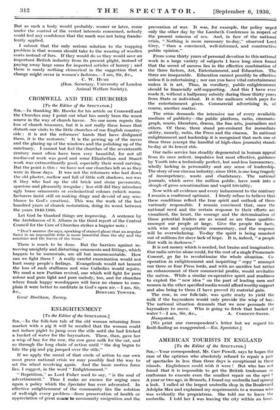[To the Editor of the SPECTATOR.] SIR,—An article under the
above title published in last week's Spectator suggests that the fur trade is not nowadays an excessively cruel trade, and urges the institution of a " hu- manely-killed guarantee" for farmed furs. But the trade papers state that only five- or six per cent., even of Canadian and American furs, come from fur farms ; and the trap- makers' catalogues indicate that the trap ordinarily employed for the remainder is that horrible instrument of torture the steel gin. The suggestion that" recent practice" in the trade is free from cruelty is, therefore, calculated to lead the public to believe what is known to be untrue. Moreover, there are strong objections to the practice of raising wild species in close captivity, and stronger justification than the caprice of fashion is needed for it.
Finally, it does not seem practicable to institute a reliable guarantee for distinguishing farmed furs from trapped furs, except in the case of domestic species and the silver fox. It is true that a mark, to be applied to the skin and carrying the right of transfer to the lining of the finished garment, could probably be registered under the Trade Marks Acts, provided that a body competent to administer the mark could be formed. But as such a body would probably, sooner or later, come under the control of the vested interests concerned, nobody could feel any confidence that the mark was not being fraudu- lently applied.
I submit that the only serious solution to the trapping problem is that women should take to the wearing of woollen coats instead of furs. If they would do so they would save an important British industry from its present plight, instead of paying away large sums for imported articles of luxury ; and there is surely nothing chimerical in the suggestion that a change might occur in women's fashions.—I am, Sir, &c.,
C. W. lit-ME
(Hon. Secretary, University of London Animal Welfare Society).































 Previous page
Previous page